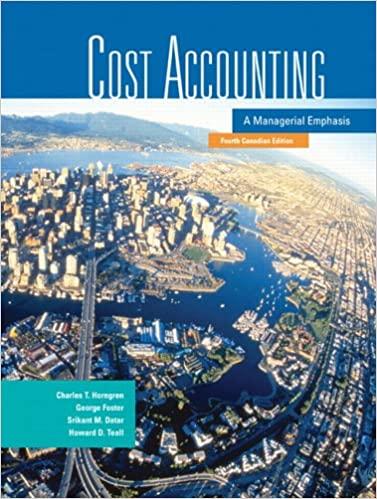Joint-costs allocation, relevant costs. (R. Capettini, adapted) Consider the following scenario. Each day a butcher buys a
Question:
Joint-costs allocation, relevant costs. (R. Capettini, adapted) Consider the following scenario. Each day a butcher buys a 200-pound pig for $360. The pig can be processed to yield the following three products:
Selling Price Weight per Pound (Pounds)
Pork chops $4.80 30 Ham $3.60 50 Bacon $1.44 120 200 Day 1 The butcher buys a pig. The $360 joint cost ofthe pig is allocated to individual products based on the relative weights ofthe products.
Selling Price Weight
(Pounds) Revenues Joint Costs
— Allocated =
Operating Income Pork chops $4.80 30 $144.00 $ 54.00 = $ 90.00 Ham 3.60 50 180.00 $ 90.00 = 90.00 Bacon 1.44 120 172.80 216.00 = (43.20)
$496.80 $360.00 = $136.80 Day 2 The butcher buyrs an identical pig and throws out the bacon because it has been shown to lose money. She now has 80 pounds of “good output.”
Selling Weight Joint Costs Operating Price (Pounds) Revenues — Allocated ~ Income Pork chops $4.80 30 $144 $135.00 = $ 9.00 Ham 3.60 50 180 225.00 = (45.00)
$324 $360.00 = $(36.00)
Day 3 The butcher buys an identical pig and throws out the ham and the bacon because they have been shown to lose money. She now has 30 pounds of “good output.”
Selling Weight Joint Costs Operating Price (Pounds) Revenues — Allocated = Income Pork chops $4.80 30 $144 $360.00 $(216.00)
$144 $360.00 = $(216.00)
Day 4 The butcher buys an identical pig and throws out the whole pig because each product has been shown to lose money. Therefore, she loses $360.
Required 1. Comment on the preceding series of decisions.
2. How would the joint costs be allocated to all three products using the sales value at splitoff method?
3. Should the operating income numbers from requirement 2 be used to determine if the butcher is better off by selling or not selling individual products? Explain briefly.
/i5-33 Joint and byproducts, estimated net realizable value method. (CPA) The Harrison y ^^Corporation produces three products—Alpha, Beta, and Gamma. Alpha and Gamma are joint products, and Beta is a byproduct of Alpha. No joint costs are to be allocated to the byproduct. The production processes for a given year are as follows:
a. In Department 1, 110,000 kilograms of direct material, Rho, are processed at a total cost of
$144,000. After processing in Department 1, 60% of the units are transferred to Department 2, and 40% ofthe units (now Gamma) are transferred to Department 3.
b. In Department 2, the material is further processed at a total additional cost of
$45,600. Seventy percent ofthe units (now Alpha) are transferred to Department 4,
and 30% emerge as Beta, the byproduct, to be sold at $1.44 per kilogram. Separable marketing costs for Beta are $9,720.
c. In Department 4, Alpha is processed at a total additional cost of $28,392. After this processing, Alpha is ready for sale at $6.00 per kilogram.
d. In Department 3, Gamma is processed at a total additional cost of $198,000. In this department, a normal loss of units of Gamma occurs, which equals 10% of the good output of Gamma. The remaining good output of Gamma is then sold for $14.40 per kilogram.
Required 1. Prepare a schedule showing the allocation of the $144,000 joint costs between Alpha and Gamma using the estimated NRV method. The estimated NRV ofBeta should be treated as an addition to the sales value ofAlpha.
2. Based on the above numbers, prepare an income statement through gross margin for Alpha using the following facts:
a. During the year, sales ofAlpha were 80% ofthe kilograms available for sale. There was no beginning inventory.
b. The estimated NRV of Beta available for sale is to be deducted from the cost of producing Alpha. The ending inventory of Alpha is to be based on the net costs of production.
c. All other cost and selling price data are listed in
(a) to (d).
Step by Step Answer:

Cost Accounting A Managerial Emphasis
ISBN: 9780131971905
4th Canadian Edition
Authors: Charles T. Horngren, George Foster, Srikant M. Datar, Howard D. Teall





